Circle hooks have revolutionized fishing, offering anglers a more efficient and humane way to catch fish. Unlike traditional J-hooks, circle hooks are designed to hook the fish in the corner of the mouth, reducing the likelihood of gut hooking and making catch-and-release fishing more successful. Here’s a comprehensive guide to help you choose the right circle hooks for your fishing needs.
1. Understanding Circle Hooks
Circle hooks are unique because of their curved shape and inward-facing point. When a fish takes the bait, the hook slides out of its throat and catches on the corner of its mouth as it turns away. This design minimizes harm to the fish and increases your chances of a successful catch.
2. Choosing the Right Size
The size of the circle hook you choose depends on the type of fish you’re targeting:
- Small Fish: For smaller species like panfish or trout, opt for smaller hooks in the 1/0 to 3/0 range. These hooks are delicate enough for light biters but still effective in securing a catch.
- Medium Fish: For species like bass or walleye, choose hooks in the 4/0 to 6/0 range. These provide a good balance of strength and subtlety, perfect for a wide range of freshwater fish.
- Large Fish: For bigger species like catfish, pike, or saltwater game fish, go for larger hooks in the 7/0 to 10/0 range. These hooks are strong enough to handle the fight without bending or breaking.
3. Material Matters
Circle hooks are made from various materials, each with its own benefits:
- High Carbon Steel: These hooks are strong and durable, ideal for bigger fish and tough fishing conditions.
- Stainless Steel: Stainless steel hooks are corrosion-resistant, making them perfect for saltwater fishing.
- Bronze: Bronze hooks are a good option for freshwater fishing. They’re strong and have a natural resistance to corrosion.

4. Barbed vs. Barbless Hooks
- Barbed Hooks: These are traditional hooks with a small, backward-facing barb that helps keep the fish on the line. They’re great for ensuring that your catch doesn’t escape, but they can cause more damage to the fish.
- Barbless Hooks: Designed for catch-and-release fishing, barbless hooks are easier to remove and cause less harm to the fish. They require a bit more skill to keep the fish hooked, but they’re worth it for the conservation-minded angler.
5. Hook Strength and Thickness
When selecting a circle hook, consider the strength and thickness. Thicker hooks are better suited for heavy fish or when using tough baits. However, they require more force to penetrate, so make sure your tackle is up to the task.
6. Setting the Hook: The Circle Hook Technique
One of the most important things to remember when using circle hooks is that you don’t need to set the hook like you would with a J-hook. Instead, simply start reeling in when you feel the fish bite. The design of the hook will do the work for you, setting itself in the corner of the fish’s mouth as it turns away.
7. Application and Versatility
Circle hooks are incredibly versatile and can be used in various fishing environments:
- Saltwater Fishing: Ideal for species like tuna, tarpon, and marlin, circle hooks are preferred in saltwater because of their effectiveness in ensuring a secure catch.
- Freshwater Fishing: For bass, catfish, and other freshwater species, circle hooks are excellent for reducing gut hooking, especially when using live bait.
- Catch and Release: If you’re focused on conservation, circle hooks are the go-to choice, as they are less likely to cause fatal injuries to fish.
Circle hooks have become a favorite among anglers for their efficiency, effectiveness, and fish-friendly design. By choosing the right size, material, and style, you can increase your success on the water while minimizing harm to the fish. Whether you’re a seasoned angler or new to the sport, mastering the use of circle hooks will undoubtedly enhance your fishing adventures.





